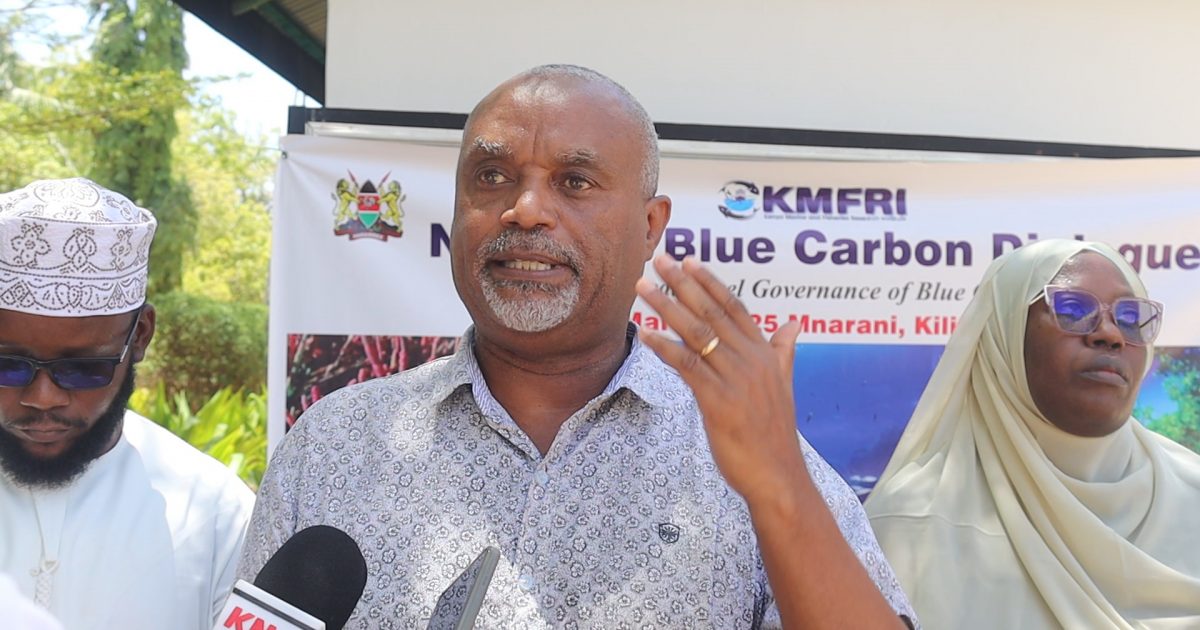As calamities caused by climate change continue to be witnessed in the country and worldwide, stakeholders from various government agencies and non-governmental organisations have met in Kilifi to discuss nature-based solutions with a strong focus on blue carbon conservation. Speaking to the media after the meeting, Kenya Marine and Fisheries Research Institute (KMFRI) Chief Executive Officer Dr. James Mwaluma revealed that planting mangroves and seagrass is a natural method of releasing Blue Carbon, which can, in turn, protect the environment in case of calamities.
“We are here to discuss Blue Carbon and discuss how we can use science to protect the environment. We want to see how we can generate Blue Carbon using mangroves and seagrass and we are currently working with two communities from Lamu who will benefit from this initiative,” said Mwaluma. His sentiments were echoed by James Kairo, a researcher at KMFRI, who described Blue Carbon restoration as a nature-based solution that can significantly benefit both the environment and local communities.

He further highlighted that for every acre of mangroves planted, approximately 1,500 tonnes of Blue Carbon can be sequestered, helping to mitigate the effects of climate change. “We need an environment that can effectively remove Blue Carbon from our surroundings. This is what we call a nature-based solution and it can help reduce calamities, support marine life, and benefit us as humans,” Kairo explained.
On his part, Dr. Emmanuel Nzai, the Director of Jumuiya ya Kaunti za Pwani (JKP), who is also the chair of the Kenya Vision 2030 Board, emphasised the economic potential of Blue Carbon through natural resources. “It’s true that when we talk about mangroves and even dryland plants like coconuts and mangoes, they all contribute to Blue Carbon conservation,” Nzai stated.
Nzai further emphasised the need to formulate laws and policies that recognise mangroves as one of the major cash crops, just like coffee and tea, so as to benefit the coastal residents. “We need to put policies in place that recognise mangroves as one of the major cash crops, like coffee and tea, to benefit the coastal residents,” he concluded. On his part, the Director of the Kenya Forest Service (KFS) coastal region reaffirmed the agency’s mandate to conserve mangroves, noting key challenges including illegal cutting of mangroves, livestock grazing in young mangrove areas, and inadequacy of enforcement.
However, Mburu revealed that KFS has increased enforcement personnel and is collaborating with partners to restore degraded mangrove forests. We work with communities to plant more trees, but on the side of mangroves, there is a lot of destruction. Hence, we have added more police to the sector of mangrove preservation,” Mburu said.
With the increasing threats posed by climate change, the national dialogue on Blue Carbon aims to strengthen conservation efforts, promote sustainable policies, and ensure that coastal communities benefit from Blue Carbon initiatives..
Environment

Blue Carbon projects empower coastal communities

As calamities caused by climate change continue to be witnessed in the country and worldwide, stakeholders from various government agencies and non-governmental organisations have met in Kilifi to discuss nature-based solutions with a strong focus on blue carbon conservation. Speaking to the media after the meeting, Kenya Marine and Fisheries Research Institute (KMFRI) Chief Executive...















